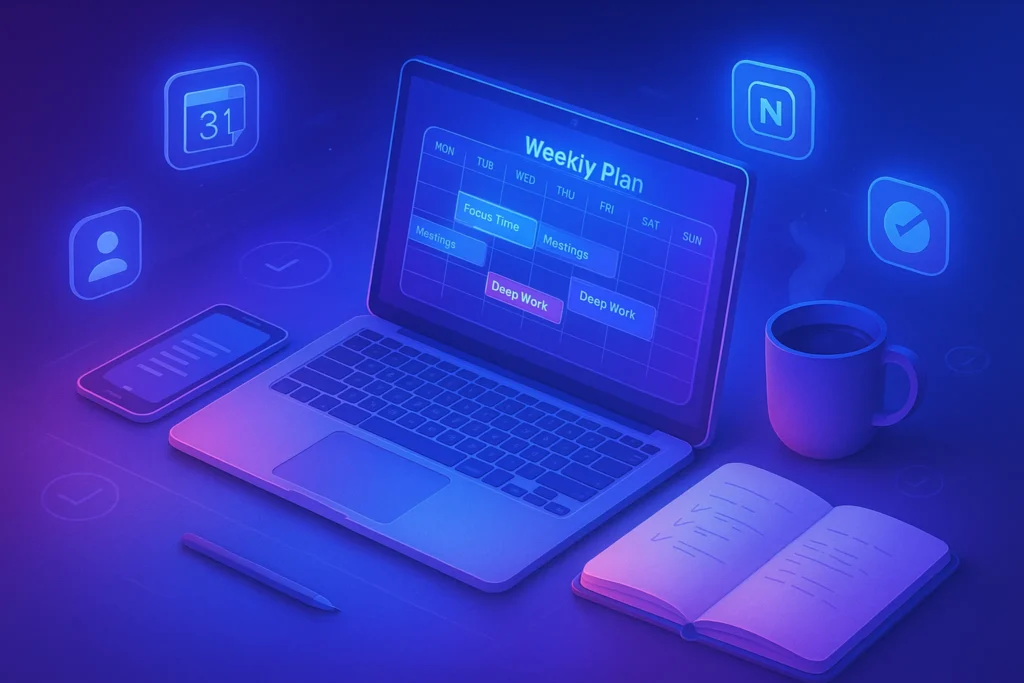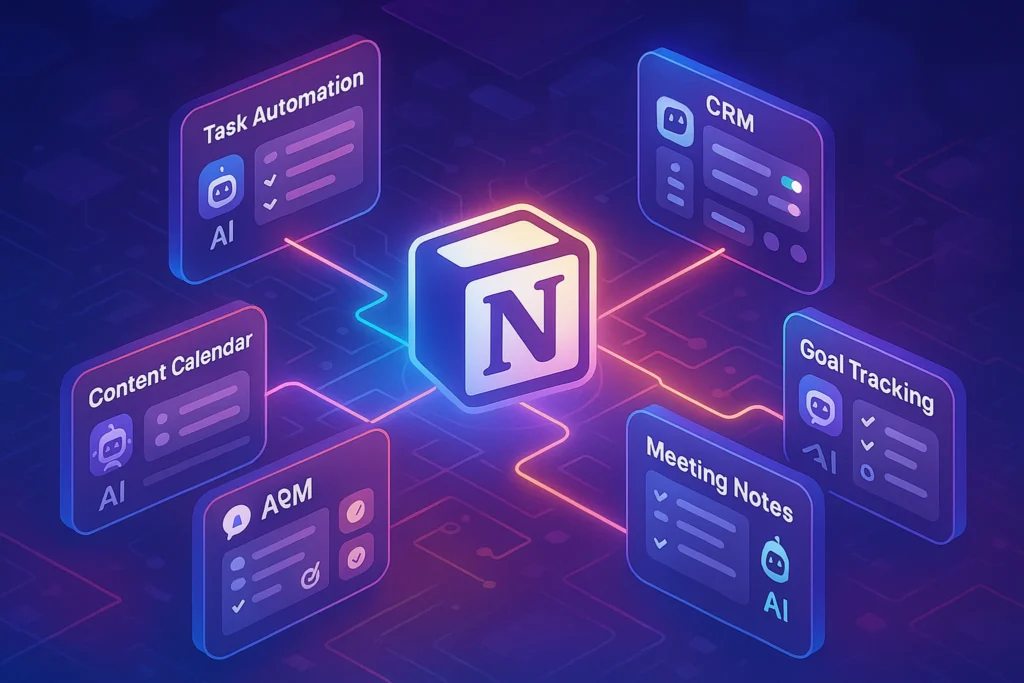-This post may contain affiliate links. If you click on one and make a purchase, I may earn a small commission at no extra cost to you.-
💡 Introduction
Feeling like your weeks are chaotic and reactive rather than proactive? You’re not alone. Busy professionals often drift from task to task instead of owning their time.
Structured weekly planning changes everything—when done right. In this guide, you’ll discover:
-
Essential mindset shifts for deliberate planning
-
A step-by-step weekly ritual
-
Tool recommendations to simplify execution
-
Real-world examples you can replicate
-
Integration with broader systems like Notion (see our guide on How to Set Up a Productivity System That Actually Works (Step-by-Step Guide))
By the end, you’ll feel grounded, in control, and ready to accomplish your most important work with ease.
📋 Weekly Planning System: 5 Core Steps
1️⃣ Step 1: 📅 Capture & Review Everything
Before you can plan a winning week, you need full visibility on your current commitments—what’s unfinished, what’s hiding, and what’s been forgotten.
Here’s how to run a Weekly Capture session:
-
Calendar Sweep: Look at the past 7 days—any meetings, appointments, or deadlines that need follow-up?
-
Task Systems: Open your Notion, ClickUp, or physical notebook. Review your to-do lists, “maybe” tasks, and half-finished projects.
-
Inbox Scan: Flag any emails that require action. Use labels like “Next Week” or “Waiting On.”
Drop everything into a “Weekly Planning Inbox” (Notion page, Google Doc, etc.). Don’t organize yet—just get it all visible.
Think of this step as clearing your mental RAM. You can’t plan clearly when your brain is juggling fragments.
Start with clarity—over the past week:
-
Export calendar events
-
Check task lists (Notion, ClickUp, Trello, etc.)
-
Scan your inbox for follow-ups or blocked tasks
Commit 30 minutes to this “collect and surface” process. Store everything in one place (e.g., the weekly inbox in your Notion dashboard).
2️⃣ Step 2: 🌟 Choose Your 3 Big Wins
Now that everything’s visible, identify the 3 biggest outcomes you want by week’s end.
Your criteria:
-
Moves the needle toward a key goal or KPI
-
Will make the rest of the week easier or more aligned
-
Has clear definition of “done” (so you don’t let it drag)
Example:
-
✅ Good: “Publish the new blog post on AI writing tools (incl. final edit + upload)”
-
❌ Bad: “Work on content stuff”
Once defined, these 3 tasks are your North Stars. Every smaller task should ladder up to one of them.
Place these tasks somewhere you’ll see daily—dashboard, calendar, sticky note.
Decide on your “Most Impactful Tasks” (MITs) for the week—no more than 3:
-
These are the tasks that align with your goals or OKRs.
-
Avoid filling every slot—leave buffer for flexibility and downtime.
Scene: On Monday morning, your whiteboard—or digital planner—should show just these priority goals, guiding every minor task.
3️⃣ Step 3: 🧩 Time Block & Schedule Strategically
Time blocking isn’t about stuffing your week—it’s about giving your top tasks protected space to breathe.
Here’s how to do it:
-
Choose time slots where energy is highest (e.g., 9am–12pm for deep work)
-
Assign 1 MIT per day max (unless you’re 100% confident in capacity)
-
Add buffer blocks: “Admin time,” “Catch-up,” or “Creative Buffer”
Use tools like:
-
Google Calendar for drag‑and‑drop blocking
-
Sunsama to visually map tasks to time slots
-
Notion + Timeline View for integrated task/calendar tracking
Pro Tip: Color-code your calendar. Green for creative, red for meetings, blue for buffer. Your week should “look” balanced.
Also—don’t forget to schedule personal things: gym, walk, family time. If it’s not on the calendar, it’s at risk of getting dropped.
Schedule your week:
-
Block chunks for your MITs (2–4 hours each)
-
Include routine tasks and admin time
-
Weave in personal time—exercise, meals, creativity
Tools like Sunsama or integrated Notion calendars help you balance structure and flexibility. They let you visually allocate time, track progress, and plan reassignments.
4️⃣ Step 4: 🔄 Plan the Day Each Evening
Each night, take 5–10 minutes to preview the next day:
-
Confirm your Top 3 tasks
-
Preload decision-making: which task is first, how long, what tools are needed
-
Visualize your day—morning to night—as if it already happened successfully
This small ritual removes the “morning panic scroll” where you waste 30 minutes deciding what to do. Instead, you start the day in motion.
Some tools to make this stick:
-
Habit app reminders (e.g., Streaks)
-
Notion template with daily slots: “Top 3 – Morning – Afternoon – Wins”
Optional: Reflect on what felt good or frustrating that day. Tiny notes now = big patterns later.
Each evening, open your calendar and:
-
Confirm tomorrow’s top 3 + buffer tasks
-
Reflect briefly: what went according to plan? what didn’t?
-
Visualize success: imagine your morning routine, focused work, and breaks
This nightly ritual primes your mind—so you wake up aligned and ready.
5️⃣ Step 5: 🧠 Reflect & Adjust Weekly
By Friday evening or Sunday morning, take 20–30 minutes to reflect:
-
What did I actually complete?
-
Where did I feel most focused? Where did I feel blocked?
-
What fell through—and why?
Use this insight to redesign next week.
Build a weekly feedback loop in Notion:
-
3 Wins
-
2 Stuck Points
-
1 Big Learning
-
Score (1–10) for focus, energy, clarity
Optional: Track this over weeks to spot trends—like Monday overloads or recurring distractions.
Weekly reviews are where pros evolve. They don’t just “work hard”—they work smarter next week.
End your week with a 20-minute review:
-
What completed tasks moved the needle?
-
Which time slots consistently failed—or succeeded?
-
Did your top 3 drive results—or distract?
Use this input to refine next week’s structure. Add context-rich notes to your planner so your system evolves with you.
🔧 Tools to Supercharge Your Week
-
Notion: build dashboards, weekly inboxes, and templates
-
Sunsama: blend task lists with calendar and reflection prompts
-
Google Calendar / Outlook: for time blocking and reminders
-
Habitica / Streaks: add habit routines Fridays (e.g., review rituals)
For a holistic system that sits atop this weekly plan, check out our guide on How to Set Up a Productivity System That Actually Works…—it’s the backbone to your week.
🔄 Bonus 1: What to Do When the Week Doesn’t Go as Planned
Even the best-laid plans will sometimes collapse. Life happens—clients cancel, unexpected requests pop up, your energy dips. But pros don’t panic—they pivot.
The key is to plan for imperfection. Start by building margin into your schedule: don’t block 100% of your available time. Reserve 10–20% of your week as “adjustable space.” This is where you move dropped tasks or create catch-up blocks.
When a day implodes, don’t try to replicate everything. Instead:
-
Identify your minimum viable progress for the week.
-
Reassign high-impact items to future blocks (Sunsama and Notion make this drag-and-drop simple).
-
Use a reflection journal to log what triggered the disruption—was it internal (procrastination, energy) or external (surprise meeting)?
It’s not about staying rigid. It’s about staying committed to your goals—even when the route changes.
-
Build 10–20% margin in your schedule
-
Use drag-and-drop tools to reassign, not cancel
-
Reflect on causes, not just consequences
📌 Key takeaway: Flexibility is a feature, not a flaw. Weekly planning isn’t destroyed by disruption—it’s strengthened by intentional course correction.
⏰ Bonus 2: The Sunday Planning Reset Ritual
Sunday is not just for rest—it’s your strategic edge.
A consistent Sunday reset ritual helps you:
-
Clear last week’s mental residue
-
Realign with current goals
-
Set the tone for a focused, intentional week ahead
Here’s what a simple, powerful Sunday Planning Ritual could look like:
-
Reflect – What were last week’s 3 wins? Where did things fall off? (5 min)
-
Review – Look at your goals, project timelines, and energy trends. (10 min)
-
Reset – Clean your workspace, inbox, and calendar. Archive what’s done. (10 min)
-
Plan – Set your MITs (Most Important Tasks), anchor habits, and time blocks. (10–15 min)
This ritual is your weekly system refresh. It’s when you return to intention—not reaction.
-
Reflect, review, reset, and plan
-
Use 30–40 minutes with calming cues
-
Set MITs and anchor habits for the week ahead
Nerd Tip: Use calming cues like music, tea, or journaling to make this ritual enjoyable and sustainable.
⚡ Bonus 3: Plan for Energy, Not Just Time
Time-blocking your calendar is helpful. But what if you block creative work during your lowest energy window?
Energy-aware planning is the next level. Instead of asking “What time do I have available?” ask:
“When do I have the most focus for deep work?”
“When do I need breaks for movement or recovery?”
Start by tracking your energy levels over 7–10 days. Note when you feel sharpest, sluggish, creative, or irritable.
Use those patterns to:
-
Assign deep work in high-energy zones (e.g., 9–11am)
-
Save admin, meetings, or calls for mid-afternoon
-
Block creative or ideation time when you’re naturally reflective (e.g., 4–6pm)
-
Track personal energy patterns
-
Assign tasks to natural high/low energy zones
-
Reduce burnout, improve task quality
This approach turns planning from task management to biological alignment—which drastically improves follow-through and reduces burnout.
📊 Bonus 4: Build Your Weekly Planning Dashboard (Template Guide)
A great weekly plan deserves a great system.
You don’t need 10 tools—just one clean, personalized dashboard that brings everything together.
What your weekly planning template could include:
-
Inbox – where all tasks, ideas, and emails are collected
-
Top 3 Goals – updated every week and reviewed daily
-
Time Blocks Calendar – visual breakdown of your actual week (Notion, Sunsama, or Google Calendar)
-
Reflection Log – 2-minute nightly notes, and end-of-week insights
-
Use Notion + Calendar to centralize the plan
-
Structure: Inbox, Top 3, Calendar, Reflection
-
Templates build consistency, visibility, and calm
Notion is a great choice here, especially if you’re already using it for task management. Combine it with Google Calendar and Habit trackers like Streaks or Sunsama for an end-to-end flow.
If you’re new to this, grab a free Notion template and start customizing. The key isn’t perfection—it’s visibility and rhythm.
🧠 Nerd Verdict
Weekly planning isn’t about perfection—it’s about deliberate choices, consistency, and adjustment. By capturing everything, focusing on impact, time-blocking, reflecting each evening, and reviewing weekly, you create a self-improving feedback loop.
This approach gives you the freedom to breathe and the confidence to deliver.
❓ FAQ
Q: What’s the best day/time to plan my week?
A: Sunday evening or Monday morning works well—choose a slot when your mind is rested and your week hasn’t begun.
Q: Can this system adapt monthly or quarterly?
A: Absolutely—use the same capture→reflect→plan cycle on a larger scale for check-ins and alignment.
Q: Do I need paid tools?
A: No. Even a pen + paper calendar works. But digital tools like Notion and Sunsama add speed and integration.
💬 Would You Bite?
Which of these 5 steps feels most game-changing to you—capture, plan, or reflect?
Let’s refine your weekly planning together. 👇



